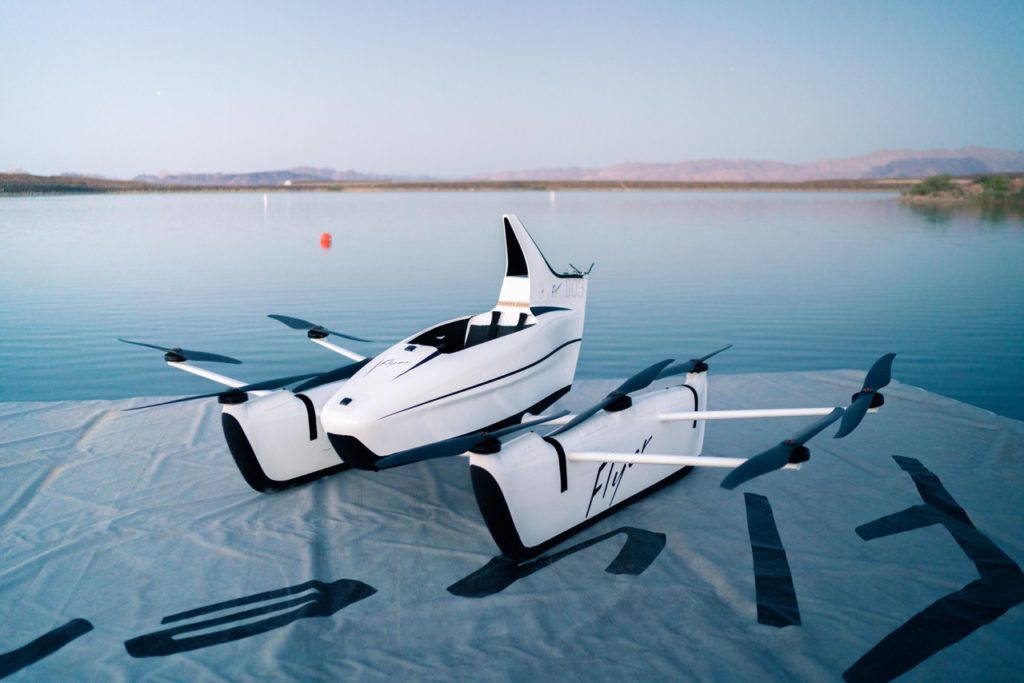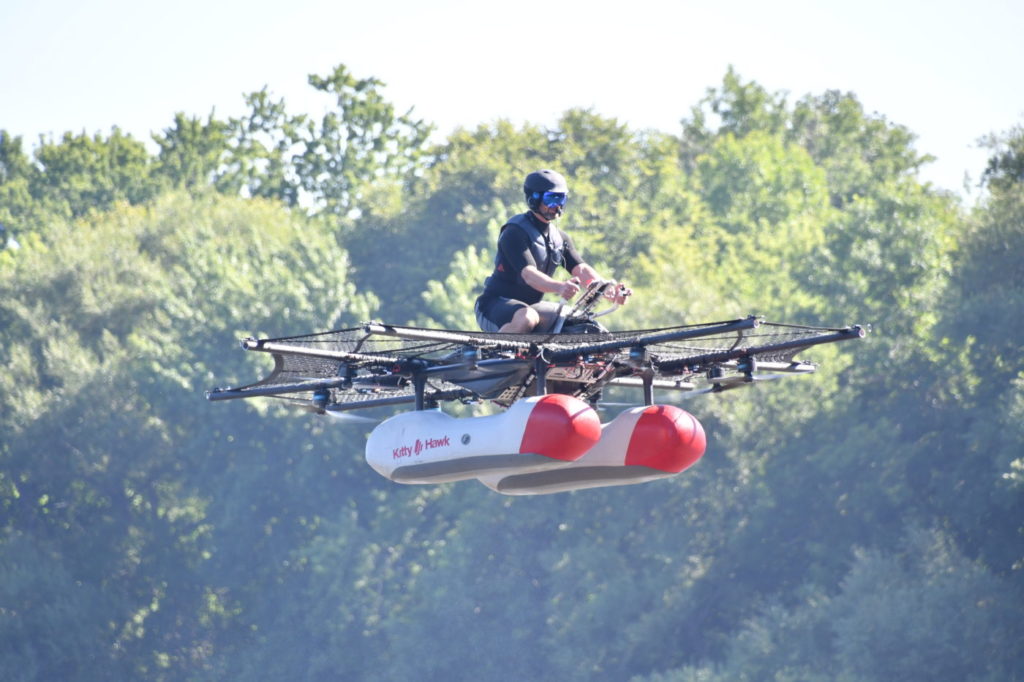Estimated reading time 5 minutes, 54 seconds.
Imagine flying low over a lake in a personal rotorcraft that doesn’t require a pilot’s licence–and in which you need just an hour of training before your first solo flight.
This vision is quickly becoming a reality after Kitty Hawk Corporation revealed the production version of its single-seat Flyer–an electric-powered 10-rotor vertical takeoff and landing (eVTOL) aircraft–near Las Vegas, Nevada, on June 6.

The aircraft’s design has come a long way since the prototype Kitty Hawk Flyer for “personal transportation” over water was revealed in a flight demonstration video on April 24, 2017, and publicly debuted at EAA AirVenture Oshkosh in July 2017.
The prototype featured a motorcycle (or personal watercraft) style seat and handlebars, a pair of floats and eight electric-powered propellers covered by protective netting. Endurance was about three minutes.
Today’s streamlined Flyer has an aerodynamic and waterproof single-seat bobsled-like composite chassis. It is flown using two side sticks that control 10 electric-powered fixed-pitch composite lift fans, which are mounted on the top of the pair of floats and twin outrigger booms.
The eight-foot-long by 13-foot-wide Flyer is powered by lithium-polymer batteries and equipped with multiple smart sensors to make flying intuitive and easy.
Kitty Hawk has initially limited the aircraft to flights between three to 10 feet off the water and 20 miles per hour. Battery life will depend on participant weight, environmental factors, and forward speed. Flights will last between 12 and 20 minutes (at 20 mph).
Some have compared Flyer to a manned electric drone. In fact, the Flyer is designed to meet the Federal Aviation Administration’s Part 103 Ultralight regulations, which means it can only be flown in daylight and uncongested areas. These regulations also limit the aircraft to an maximum empty weight of 254 pounds and “55 knots calibrated airspeed at full power in level flight.”

Parallel to the design changes, Kitty Hawk seems to have updated the business strategy behind introducing the Flyer to the market.
Last year, the company said it was developing an eVTOL “you can buy” by the end of 2017. Now the marketing emphasis has shifted to finding partners interested in operating their own fleet of Flyers “to give people access to the freedom of flight” and offering pre-sales to the company’s invitation-only Founder Flyers group.
Kitty Hawk was founded (as Zee.Aero) in March 2010 by billionaire Larry Page, the co-founder of Google and the CEO of Alphabet Inc. – one of the richest men in the world.
The Flyer engineering and design team is led by Dr. Todd Reichert and Cameron Robertson, two Canadians who led Aerovelo — the University of Toronto-affiliated engineering team that won the $250,000 AHS Sikorsky prize in July 2013 for a record-setting, human-powered helicopter.
Kitty Hawk has been committed to developing a family of electric aircraft “products for work and play” since 2010.
On March 12, 2018, Kitty Hawk unveiled that it had been flying Cora, a two-seat derivative of the Zee Aero Z-P2 eVTOL aircraft, in California and in New Zealand.
The 36-foot (11 meter) wingspan Cora features 12 independent electric powered lift fans, which enable it to take off and land vertically like a helicopter. Once airborne, the aircraft transitions to forward flight using the thrust from a single three-blade pusher propeller. It is also fitted with a ballistic parachute for use in an emergency.

The design of this VTOL aircraft evolved several times. The first self-piloted (unpiloted) proof of concept aircraft hovered in December 2011 and transitioned to forward flight in February 2014 at Hollister Airport, California. The prototype Z-P2 flew for the first time with a human onboard in August 2017.
In October 2017, one of the three Cora prototypes was shipped to New Zealand and became the first to fly (self-piloted) soon afterwards. The first self-piloted transition from a hover to forward flight took place in California in November.
Cora has an initial range of about 62 miles (100 kilometers), a top speed of about 110 mph (180 kilometer per hour) and is designed to operate at altitudes between 500 and 3,000 feet (150 meters to 900 meters) above the ground.
Zephyr Airworks, Kitty Hawk’s operator in New Zealand, is working with the local government, businesses and local communities to make the dream of everyday flight a reality.
Kitty Hawk’s Flyer and Cora eVTOL are applications of distributed electric propulsion, where electric motors and lift fans have replaced complex, heavy and expensive rotor systems.
According to the Vertical Flight Society, there are now 80 different eVTOL aircraft in development around the world, which have attracted more than $1 billion in financing.








